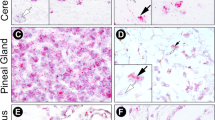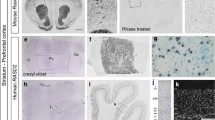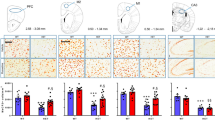Abstract
Ataxic Rora sg (staggerer) mouse mutants, containing a deletion of the Rora gene which encodes a retinoid-like nuclear receptor, were compared to non-ataxic controls for concentrations of 5-hydroxytryptamine (HT), its main metabolite (5-hydroxy-indole acetic acid, 5HIAA), and its precursor (tryptophan) in cerebellum, brainstem, and forebrain. In Rora sg cerebellum, 5HT concentrations increased relative to controls, while tryptophan concentrations decreased. 5HIAA concentrations increased in mutant cerebellum and brainstem, but the 5HIAA/5HT ratio declined only in cerebellum. These results indicate that 5HT turnover decreased in cerebellum of an ataxic mutant, perhaps indicative of presynaptic accumulation and compromised neurotransmission and susceptible to be modified by 5HT pharmacotherapy.
Similar content being viewed by others
References
Hamilton BA, Frankel WN, Kerrebrock AW et al (1996) Disruption of the nuclear hormone receptor RORα in staggerer mice. Nature 379:736–739
Ino H (2004) Immunohistochemical characterization of the orphan nuclear receptor RORα in the mouse nervous system. J. Histochem. Cytochem. 52:311–323
Nakagawa S, Watanabe M, Inoue Y (1997) Prominent expression of nuclear hormone receptor RORα in Purkinje cells from early development. Neurosci. Res. 28:177–184
Sashihara S, Felts PA, Waxman SG et al (1996) Orphan nuclear receptor ROR gene: isoform-specific spatiotemporal expression during postnatal development of brain. Brain Res. Mol. Brain Res. 42:109–117
Herrup K, Mullen RJ (1979) Regional variation and absence of large neurons in the cerebellum of the staggerer mouse. Brain Res. 172:1–12
Herrup K (1983) Role of staggerer gene in determining cell number in cerebellar cortex. I. Granule cell death is an indirect consequence of staggerer gene action. Brain Res. 11:267–274
Landis DM, Sidman RL (1978) Electron microscopic analysis of postnatal histogenesis in the cerebellar cortex of staggerer mutant mice. J. Comp. Neurol. 179:831–863
Shojaeian H, Delhaye-Bouchaud N, Mariani J (1985) Decreased number of cells in the inferior olivary nucleus of the developing staggerer mouse. Brain Res. 21:141–146
Blatt G, Eisenman L (1985) A qualitative and quantitative light microscopic study of the inferior olivary complex in the adult staggerer mutant mouse. J. Neurogenet. 2:51–66
Roffler-Tarlov S, Herrup K (1981) Quantitative examination of the deep cerebellar nuclei in the staggerer mutant mouse. Brain Res. 215:49–59
Deiss V, Strazielle C, Lalonde R (2000) Regional brain variations of cytochrome oxidase activity and motor co-ordination in staggerer mutant mice. Neuroscience 95:903–911
Lalonde R (1987) Motor abnormalities in staggerer mutant mice. Exp. Brain Res. 68:417–420
Lalonde R, Bensoula AN, Filali M (1995) Rotorod sensorimotor learning in cerebellar mutant mice. Neurosci. Res. 22:423–426
Bishop GA, Ho RH (1985) The distribution and origin of serotonin immunoreactivity in the rat cerebellum. Brain Res. 331:195–207
Ohsugi K, Adachi K, Ando K (1986) Serotonin metabolism in the CNS in cerebellar ataxic mice. Experientia 42:1245–1247
Lane JD, Nadi NS, McBride WJ et al (1977) Contents of serotonin, norepinephrine and dopamine in the cerebrum of the “staggerer”, “weaver” and “nervous” neurologically mutant mice. J. Neurochem. 29:349–350
Gibson CJ, Deikel SM, Young SN et al (1982) Behavioural and biochemical effects of tryptophan, tyrosine and phenylalanine. Psychopharmacology 76:118–121
Ghetti B, Perry KW, Fuller RW (1988) Serotonin concentration and turnover in cerebellum and other brain regions of pcd mutant mice. Brain Res. 458:367–371
Reader TA, Le Marec N, Ase AR et al (1999) Effects of l-tryptophan on indoleamines and catecholamines in discrete brain regions of wild type and Lurcher mutant mice. Neurochem. Res. 24:1125–1134
Strazielle C, Lalonde R, Riopel L et al (1996) Regional distribution of the 5-HT innervation in the brain of normal and Lurcher mice as revealed by [3H]citalopram quantitative autoradiography. J. Chem. Neuroanat. 10:157–171
Draski LJ, Nash DJ, Gerhardt GA (1994) CNS monoamine levels and motoric behaviors in the hotfoot ataxic mutant. Brain Res. 645:69–77
Ase A, Strazielle C, Hébert C et al (2000) The central serotonin system in dystonia musculorum mutant mice: biochemical, autoradiographic and immunocytochemical data. Synapse 37:179–193
Le Marec N, Hébert C, Amdiss F et al (1998) Regional distribution of 5-HT transporters in the brain of wild type and ‘Purkinje cell degeneration’ mutant mice: a quantitative autoradiographic study with [3H]citalopram. J. Chem. Neuroanat. 15:155–171
Cooper JR, Bloom FE, Roth RH (1996) The biochemical basis of neuropharmacology, 7th edn. Oxford, New York
Le Marec N, Ase AR, Botez-Marquard T et al (2001) Behavioral and biochemical effects of l-tryptophan and buspirone in a model of cerebellar atrophy. Pharmacol. Biochem. Behav. 69:333–342
Trouillas P, Serratrice G, Laplane D et al (1995) Levorotatory form of 5-hydroxytryptophan in Friedreich’s ataxia. Arch. Neurol. 52:456–460
Trouillas P, Xie J, Adeleine P et al (1997) Buspirone, a 5-hydroxy-tryptamine1A agonist, is active in cerebellar ataxia: results of a double-blind drug placebo study in patients with cerebellar cortical atrophy. Arch. Neurol. 54:749–752
Takei A, Hamada T, Yabe I et al (2005) Treatment of cerebellar ataxia with 5-HT1A agonist. Cerebellum 4:211–215
Acknowledgments
This work was supported by a grant from NSERC to RL.
Author information
Authors and Affiliations
Corresponding author
Rights and permissions
About this article
Cite this article
Lalonde, R., Strazielle, C. Regional Variations of 5HT Concentrations in Rora sg (staggerer) Mutants. Neurochem Res 31, 921–924 (2006). https://doi.org/10.1007/s11064-006-9096-9
Accepted:
Published:
Issue Date:
DOI: https://doi.org/10.1007/s11064-006-9096-9




